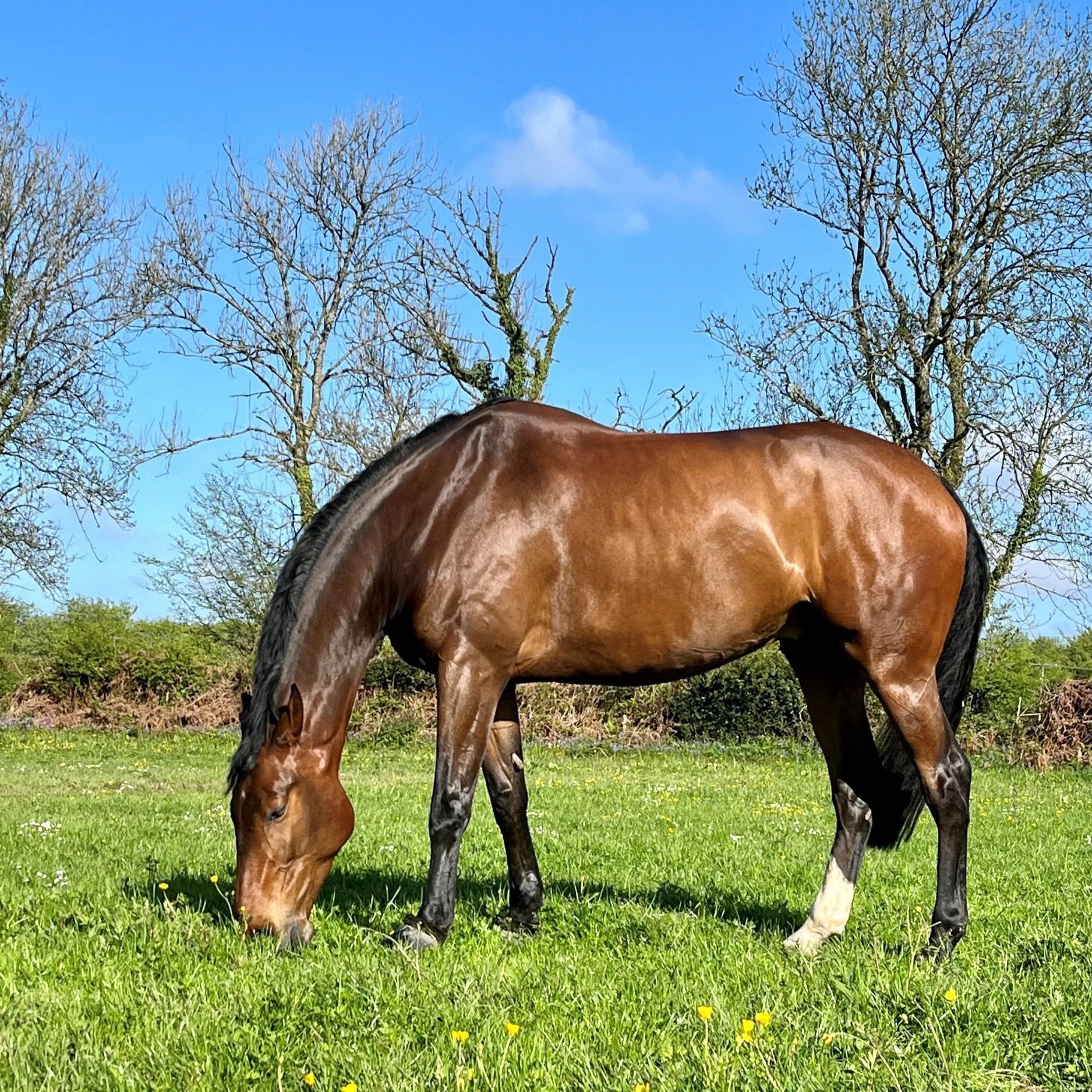Flexibility for life starts with sound, healthy joints
Our horse’s skeleton is made up of just over 200 bones, and joints occur where those bones meet. The role of joints can vary depending on type. In some, the structure is solid and immobile, but for most joints the role is to enable movement and flexibility, together with supporting weight distribution and shock absorption.
Having a basic understanding of equine joints, how they can go wrong and how we can nutritionally support them, helps us to keep our horses fit, sound and flexible for life.
Joint Anatomy
Healthy joint function is essential to rideability and performance, and relies on the proper functioning of all joint structures. Joints are complex structures including blood supply, nerves that are supported by muscles which help provide stability. As horses have no muscles in their lower leg, stability is provided by ligaments and tendons, which are connected to the muscles higher up in the leg.
Joint Structure
- Bursa - A small fluid filled sac that provides cushioning protection, reducing friction, between tendon and bone.
- Cartilage - Strong, flexible tissue covering the ends of the bones, to reduce friction, protect the bones and joint, and act as a shock absorber.
- Joint capsule - Thick fibrous sac that envelopes the whole joint, providing stability. Nerve endings here have a role to play in joint pain.
- Ligaments - Strong connective tissue, attaching bone to bone to keep them stable.
- Synovial fluid - Thick fluid within the joint cavity, between the bones, to provide lubrication.
- Synovial membrane - Lining of the joint capsule where synovial fluid is made.
- Tendons - Strong, flexible, connective tissue, attaching bone to muscle.
-
Tendon sheath - Lubricating sac around the tendon, at points where it crosses the joint, to provide protection and free movement.

Types of Joints
Horses have several types of joints that are responsible for different levels of movement.
- Fibrous - Fixed joints which are usually immovable and do not contain a joint cavity. For example, those which join the bones of the skull together. These are slightly mobile at birth, to allow passage through the birth canal, but then fully fuse.
- Cartilaginous - Either immovable or only slightly movable, and where bones are joined by cartilage. These may be ‘primary’, containing a particularly smooth cartilage, called ‘hyaline’. Examples of primary include growth plates during bone development. Or ‘secondary’, composing of particularly thick and strong cartilage, examples being between the vertebral discs of the spine.
-
Synovial - The most common joint type and the one most prone to injury or disease. The bones of the joint are covered cartilage, and the key feature of these joints is the presence of a joint cavity surrounded by the joint capsule. Synovial joints are responsible for our horse’s movement and are supported by muscles and also tendons.
Osteoarthritis
Osteoarthritis (OA), also known as Degenerative Joint Disease (DJD) is the most common joint condition of horses as well as being one of the main reasons for retiring or downgrading a horses workload, with research showing that it accounts for more than 60% of lameness cases in horses.
The predominant sign of OA in horses is lameness. This can be slowly progressive and subtle to begin with, or it can be have a more sudden onset, with affected horses often showing a reduced range of movement coupled with inflammation in the joint leading to lameness.
‘Arthritis’ is a term describing inflammation of the joint, for which there are many possible predisposing factors and causes. Osteoarthritis is a specific type of arthritis that can occur in any synovial joint and it is characterised by damage to the cartilage on the joint surface. Due to this OA is often referred to as the ‘wear and tear’ type of arthritis. By the time this becomes advanced, the occurrence of lameness and reduced flexibility is all but inevitable.
OA can sometimes be recognised from clinical presentation, however, additional techniques such as radiography, ultrasound, arthroscopy, MRI and CT are now frequently used to aid diagnosis.
A UK study of over 200 horses aged 15 or above, showed over 80% of them had reduced range of motion in at least one joint.
Supplementing for Joint Health
Joint nutrition is one area where there is lots of research across all species, including horses. Research shows that supporting the use of targeted nutrition from a quality joint supplement supports maintaining healthy joints aiming for prevention of issues rather than waiting for a problem to occur as equine cartilage, like that of other mammals, has a limited ability to regenerate.
During work, even in healthy conditions, there will always be some degree of cartilage turnover, and the greater the level and intensity of their work, the more this becomes a consideration. Therefore, we recommend to start them young to get flexibility for life!
Feeding for long-term joint health
It is never too early to start feeding to maintain joint health especially for horses in ridden work including performance horses. A study of 14 yearlings found that oral supplementation with Glucosamine helped to defend against inflammation in the joint and cartilage degradation. Whilst another study of 17 yearlings demonstrated that supplementation with a plant-based omega fatty acid both reduced cartilage degradation and increased cartilage regeneration.
How to choose the right supplement?
When choosing a joint supplement for your horse what are the key considerations, and what nutrients should you be looking for in the blend?
Cartilage Support
For working joints, and certainly early and peak career, it is vital that the blend chosen includes the building blocks of healthy cartilage. One of the best known nutrients here, and well established for horses, is Glucosamine. Though it is worth knowing that there are several types and efficacy changes with type. Equine specific research shows ‘Glucosamine sulphate’ is more bioavailable and more effective than the more commonly used ‘Glucosamine hydrochloride (HCl).
Tendons, Collagen and Synovial fluid
Essential nutrition for tendon, ligament and collagen health can be supplied through a number of nutrients. Alongside the glucosamine, sulphur donors such as MSM (methyl sulphonyl methane) or methionine, together with the amino acid glutamine, all have roles to play in collagen synthesis within cartilage, bone and joints.
Anti-inflammatory
Inflammatory compounds, known as ‘inflammatory cytokines’ are a central part of all joint damage and degradation. Therefore, it is really important that the joint complex you choose for your horse should include natural anti-inflammatories. One of the principal sources are Omega 3 fatty acids, which can be either marine or plant sourced. Whilst the fish based oils are well known, they are typically fairly unpalatable to horses, and come with environmental. Plant based options, such as Linseed or Chia provide a sustainable alternative suitable for horses. However, do be aware that many plant based oils, including soya, corn oil, rapeseed (supermarket ‘vegetable’ oil) and sunflower oil all provide too much of the pro-inflammatory Omega 6 fatty acids, and poor levels of anti-inflammatory Omega 3s.
Herbal Health
Herbs can make a popular choice for maintaining joint health, and often have a useful role to play in pain relief and antioxidant profiles. These include herbs such as turmeric, devil’s claw and boswellia. However, it is important to note that none of these contribute to joint repair or regeneration, as they do not provide the required key nutritional building blocks.
Herbal choices can be useful in maintaining comfort in older horses enjoying their retirement or light work. For horses still in active exercise, we recommend a complex of joint support nutrients.
Clean Sport
If choosing a devil’s claw product, remember that it cannot be used in competition horses. The active ingredient of devil’s claw (harpagosides) is listed on the FEI prohibited substance list as an analgesic (pain reliever).
For further information on ingredients suitable for FEI competition Click Here.
Selected References
- Goodrich LR, Nixon AJ. Medical treatment of osteoarthritis in the horse - a review. Vet J. 2006 Jan;171(1):51-69.
- Ireland JL et al. Disease prevalence in geriatric horses in the United Kingdom: veterinary clinical assessment of 200 cases. Equine Vet J. 2012 Jan;44(1):101-6.
- Marañón G, Muñoz-Escassi B, Manley W, García C, Cayado P, de la Muela MS, Olábarri B, León R, Vara E. The effect of methyl sulphonyl methane supplementation on biomarkers of oxidative stress in sport horses following jumping exercise. Acta Vet Scand. 2008 Nov 7;50(1):45.
- Meulyzer M, Vachon P, Beaudry F, Vinardell T, Richard H, Beauchamp G, Laverty S. Joint inflammation increases glucosamine levels attained in synovial fluid following oral administration of glucosamine hydrochloride. Osteoarthritis Cartilage. 2009 Feb;17(2):228-34.
- Osteoarthritis. In: Ross MW, Dyson SJ, eds. Diagnosis and management of lameness in the horse. 2nd edition. St Louis: Elsevier Saunders, 2011:655–668.
Written by
Dr Andy Richardson, Veterinary Director - BVSc CertAVP(ESM) MRCVS and
Kate Hore, Head Registered Nutritionist - RNutr(Animal), R.Anim.Technol(Cert), BSc(Hons) - Find out more about Kate, Andy and our Technical Team HERE!



